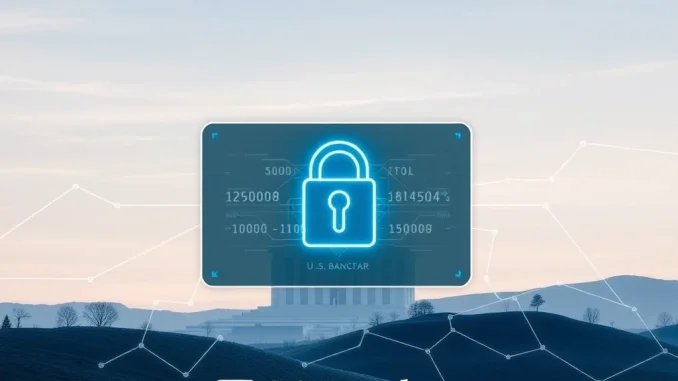
Major financial institutions are increasingly looking at the potential of digital assets, and now, U.S. Bancorp is making headlines. The bank is actively exploring opportunities related to the U.S. Bancorp Stablecoin space, with a specific eye on revolutionizing payment services. This move signals a growing interest from traditional finance in the capabilities offered by blockchain technology and stable digital currencies.
Why U.S. Bancorp is Exploring Stablecoins
According to a report citing U.S. Bancorp CEO Gunjan Kedia at the Morgan Stanley Financial Conference, the bank’s interest in stablecoins isn’t just theoretical; it’s a strategic exploration into potential business ventures. As one of the largest banks in the United States, U.S. Bancorp’s engagement in this area holds significant weight for the broader financial industry. Their focus appears to be on leveraging stablecoins to enhance existing services or build new ones, particularly within the payments ecosystem.
Several factors likely contribute to a major institution like U.S. Bancorp considering stablecoins:
- **Client Demand:** Large corporate clients are increasingly interested in faster, more efficient payment methods.
- **Competitive Landscape:** Fintech companies and other financial players are already exploring or implementing digital asset solutions.
- **Efficiency Gains:** Stablecoins offer the potential for near-instant settlements, lower transaction costs, and 24/7 processing compared to traditional systems.
- **Future-Proofing:** Engaging with digital assets prepares the bank for an evolving financial landscape where digital currencies may play a larger role.
Focusing on Stablecoin Payments: The Core Opportunity
The emphasis on Stablecoin Payments is particularly telling. Payments are a fundamental function of banking, yet traditional systems can be slow, costly, and complex, especially for cross-border transactions. Stablecoins, pegged to stable assets like the U.S. dollar, offer a potential alternative. They combine the stability required for commercial transactions with the speed and efficiency of blockchain technology.
Potential applications for U.S. Bancorp in the realm of stablecoin payments could include:
- **Faster Cross-Border Settlements:** Enabling businesses to send and receive payments globally with greater speed and lower fees.
- **Instant B2B Payments:** Facilitating real-time payments between corporate clients, improving cash flow management.
- **Treasury Management:** Offering corporate clients new tools for managing and moving funds digitally.
- **Supply Chain Finance:** Integrating payments directly into supply chain processes for greater transparency and efficiency.
This focus suggests U.S. Bancorp isn’t just exploring crypto speculatively but is looking for tangible use cases that can improve existing services or create new revenue streams within their core business.
The Broader Trend: Bank Stablecoin Initiatives
U.S. Bancorp is not alone in this exploration. The concept of a Bank Stablecoin or bank-issued digital currency has been gaining traction. JPMorgan’s JPM Coin is perhaps the most well-known example, designed for internal use and B2B payments within their network. Other banks globally are conducting pilots or researching the feasibility of tokenized deposits or stablecoins.
This trend highlights a significant shift: banks are moving from viewing crypto purely as a speculative asset class to recognizing the potential of the underlying technology (blockchain) and specific digital assets (like stablecoins) to improve financial infrastructure. The interest isn’t necessarily in volatile cryptocurrencies like Bitcoin or Ethereum for transactional purposes, but in stable, regulated digital representations of fiat currency.
Navigating the Path for US Bank Crypto Adoption
While the opportunities are clear, the path for US Bank Crypto adoption is not without challenges. The regulatory environment in the United States remains a significant hurdle. Clarity on how stablecoins will be regulated is still evolving, creating uncertainty for financial institutions.
Key challenges U.S. Bancorp and other banks face include:
- **Regulatory Uncertainty:** Lack of clear federal guidelines for stablecoins.
- **Compliance:** Ensuring Anti-Money Laundering (AML) and Know Your Customer (KYC) requirements are met in a digital asset framework.
- **Integration:** Connecting new blockchain-based systems with existing legacy banking infrastructure.
- **Security:** Protecting digital assets and transaction networks from cyber threats.
- **Adoption:** Educating clients and driving widespread use of new digital payment methods.
Despite these challenges, the fact that major players like U.S. Bancorp are publicly discussing their exploration signals a commitment to navigating this complex landscape.
The Impact of Financial Stablecoins on Traditional Finance
The successful integration of Financial Stablecoins into traditional banking systems could have profound implications. It could lead to a more efficient, interconnected, and potentially cheaper global financial system. Banks that successfully adopt and offer stablecoin services could gain a competitive edge, attracting businesses seeking modern payment solutions.
This exploration by U.S. Bancorp underscores the increasing convergence of traditional finance and digital assets. While the full impact remains to be seen, the focus on practical applications like payments suggests a serious effort to harness the benefits of this technology within the established financial framework.
Conclusion
U.S. Bancorp’s stated interest in U.S. Bancorp Stablecoin opportunities, particularly for payment services, is a significant development. It reinforces the trend of major financial institutions exploring the potential of digital assets. While regulatory and technical hurdles exist, the focus on practical applications like enhancing payment efficiency highlights the tangible benefits banks see in this technology. As the digital asset landscape matures, expect to see more traditional financial players like U.S. Bancorp actively exploring and potentially implementing solutions involving Bank Stablecoin and Stablecoin Payments, shaping the future of Financial Stablecoins and US Bank Crypto within the regulated financial system.



